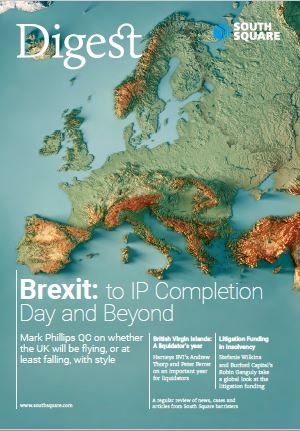

Introduction
In the last edition of the Digest (November 2019) we featured two pieces on the zeitgeisty topic of cryptoassets and cryptocurrencies: Alex Riddiford ventured down the rabbit hole to consider Bitcoin transaction avoidance and a creditor’s standing to present a bankruptcy petition in respect of unpaid Bitcoin; and we were privileged to publish Mr Justice Zacaroli’s lecture to the Insolvency Lawyers Association entitled “Crypto-currencies and insolvency”. The latter indicated that we were due an imminent statement from the UK Jurisdiction Taskforce (the “UKJT”) (under the Chairmanship of the Chancellor of the High Court, Sir Geoffrey Vos) on the legal status of cryptoassets and smart contracts.
The UKJT published its legal statement on 18 November 2019 (the “Legal Statement”). In the introduction, its authors make clear that the Legal Statement is not a treatise or an academic paper; it seeks to answer several groups of questions put to the authors in relation to the legal status of cryptoassets and, in particular, whether the law treats them as property. We are reminded that time and again over the years the common law has accommodated technological and business innovations: cryptoassets, distributed ledger technology and smart contracts are merely the most recent in a long history of fast-changing technologies.
Summary of Conclusions
Property
The UKJT have reached the following, broad conclusions on whether English law would treat a particular cryptoasset as property (whilst noting that in a given case the answer will depend on the precise nature of the asset and the rules of the system):
(a) Cryptoassets have all the indicia of property.
(b) The novel or distinctive features possessed by some cryptoassets – intangibility, cryptographic authentication, use of a distributed transaction ledger, decentralisation, rule by consensus – do not disqualify them from being property;
(c) Nor are cryptoassets disqualified from being
property as pure information, or because they might not be classifiable either as things in possession or as things in action;
(d) Cryptoassets are to be treated in principle as property;
(e) But a private key is not in itself to be treated as property because it is information.
On the ancillary question of whether a cryptoasset is a thing in possession, a thing in action, or another form of personal property, the authors concluded that, to the extent it is necessary to characterise or classify it at all, then it is best treated as being another, third kind of property, as the court was prepared to do with the EU carbon emission allowances in Armstrong v Winnington [2013] Ch 156.
As the Legal Statement indicates, this conclusion is likely to have importance in a number of areas, most notably the vesting of property in personal insolvency and the rights of liquidators in corporate insolvency. The authors point out that the definition of property in Section 4361 of the Insolvency Act 1986 is “very wide indeed”, and that so much is a deliberate decision of the legislature
to allow as many valuable assets as possible to be classified as property so that they can be collected and realised for the benefit of the estate. Even if a particular cryptoasset is not property at common law, it could still be property for the purposes of IA86 if it falls, for example, within the words “obligations and every description of interest, whether present or future or vested or contingent, arising out of, or incidental to, property”.
However, cryptoassets cannot be physically possessed: they are purely “virtual”. This means they cannot be the object of bailment, nor would it be possible to sue for conversion in respect of them. Nor are they documents of title (i.e. documents that enable the holder to deal with the property described as if they were the owners), documentary intangibles or negotiable instruments. Nor are they “goods” under the Sale of Goods Act 1979. However, if and to the extent that a certain cryptoasset is property, a mortgage or charge can be created over, just as it can be created over other intangible property; but since cryptoassets cannot be possessed, they cannot be the object of a pledge or a contractual lien.
Finally, in relation to what factors would be relevant to determining whether English law governs the proprietary aspects of dealings in cryptoassets, the authors “tentatively” suggest the following factors will be of particular relevance:
(a) Whether the relevant off-chain asset is located in England & Wales.
(b) Whether there is any centralised control in England & Wales.
(c) Whether a particular cryptoasset is controlled by a particular participant in England & Wales.
(d) Whether the law applicable to the relevant transfer (perhaps by reason of the parties’ choice) is English law.
Smart Contracts
The Legal Statement concludes that a smart contract is well capable of satisfying the basic requirements for formation of contract at common law and is therefore capable of having contractual force.
As the parties’ contractual obligations may be defined by a computer – in which case there may be little room for “interpretation” in the traditional sense – or the code may merely
implement an agreement whose meaning is to be found elsewhere – in which case the code is unimportant from the perspective of defining the agreement – the authors conclude that an English
court can in principle “interpret” a smart contract (though one assumes that expert evidence will be necessary to do this)
Finally, a private key can amount to a statutory “signature”, since an electronic signature which is intended to authenticate a document
will generally satisfy a statutory signature requirement; whilst a statutory “in writing” requirement2 can be met in the case of a smart contract whose code element is recorded in source
code (and to the extent that it is in readable format, object code). The authors of the Legal Statement conclude that in very many cases the terms of the relevant contract will not be contained in the code itself, and the correct analysis will be that the parties have agreed to be bound by the effect of whatever the code does,
rather than what it says.
The Legal Statement in Practice
In the last 18 months the English courts have started to grapple with the novel legal and factual issues thrown up by cryptoassets and cryptocurrencies: see Vorotyntseva v Money-4 Limited [2018] EWHC 2598 (Ch) (Birss J) and Liam David Robertson v Persons Unknown (unreported 15th July 2019) (Moulder J).
However, in the recent case of Aa v Persons Unknown [2019] EWHC 3556 (Comm) the Business & Property Courts (Bryan J, Commercial Court) have considered the Legal Statement for the
first time. The case concerned applications for freezing injunctions and Bankers Trust orders in the context of cryptocurrency ransom payments. In short, the applicant insurance company was hacked with malware that encrypted all its computer systems. A ransom was demanded, and paid, in Bitcoin. A specialist company tracked the transfer of 96 of the Bitcoins to a specified address linked to the exchange known as Bitfinex. Bankers Trust/Norwich Pharmacal relief and/ or a proprietary injunction was sought against a variety of defendants.
The judge noted that, in his foreword to the Legal Statement, the Chancellor had not in fact endorsed its contents, and that it followed that the statement was not in fact a statement of law. However, he considered that the analysis of the proprietary status of cryptocurrencies was compelling, and concluded that, for reasons identified in the Legal Statement, a cryptoasset such as Bitcoin is property (meeting the four criteria set out in Lord Wilberforce’s classic definition of property in National Provincial
Bank v Ainsworth [1965] 1 A C 1175 i.e. 1) definable 2) identifiable by third parties 3) capable of assumption by third parties and 4) having some degree of permanence). On that basis Bryan J found that “as elaborated upon in the Legal Statement, which I consider to be an accurate statement as to the position under English law, I am satisfied for the purpose of granting an interim injunction in the form of an interim proprietary injunction that crypto currencies are a form of property capable of being the subject of a proprietary injunction” (emphasis added).
The Legal Statement has now, therefore, been endorsed as an accurate position of English law (at least in respect of its summary conclusions on the proprietary nature of cryptoassets).
Thus begins a new chapter in the evolution of the “endlessly creative” common law, “a living law built on what has gone before, but open to constant renewal”3
1““Property” includes money, goods, things in action, land and every description of property wherever situated and also obligations and every description of interest, whether present or future or vested or contingent, arising out of, or incidental to, property”.
2Under Schedule 1 of the Interpretation Act 1978, “writing” is defined as included “typing, printing, lithography, photography and other modes of representing or reproducing words in a visible form, and expressions referring to writing are to be construed accordingly”.
3Sir John Laws, The Common Constitution, Hamlyn Lectures (Cambridge University Press 2014), 9-10.







![Brake & Anor v The Chedington Court Estate Ltd [2023] UKSC 29](https://southsquare.com/wp-content/uploads/2024/02/Brake-Anor-scaled-e1728649908896.jpeg)








![New Judgment: Re Argentex LLP [2025] EWHC 3125 (Ch)](https://southsquare.com/wp-content/uploads/2025/06/alejandro-pohlenz-gYbOFTwcJx4-unsplash-scaled.jpg)
